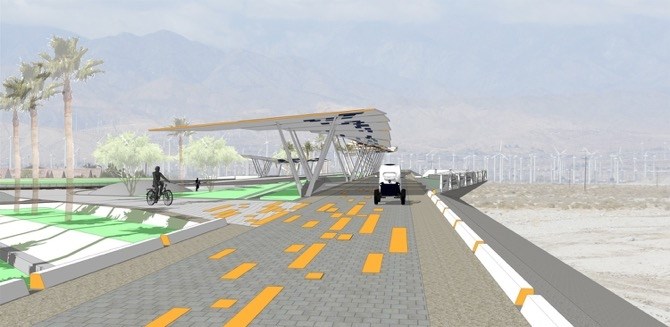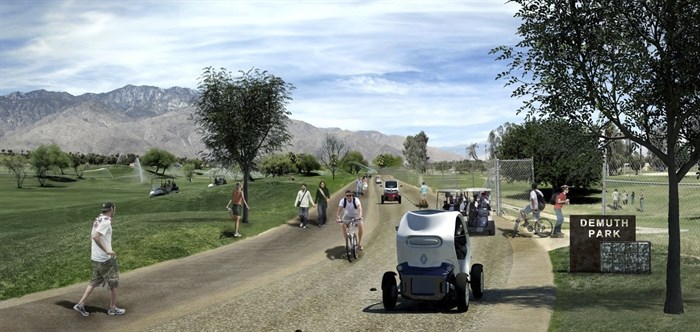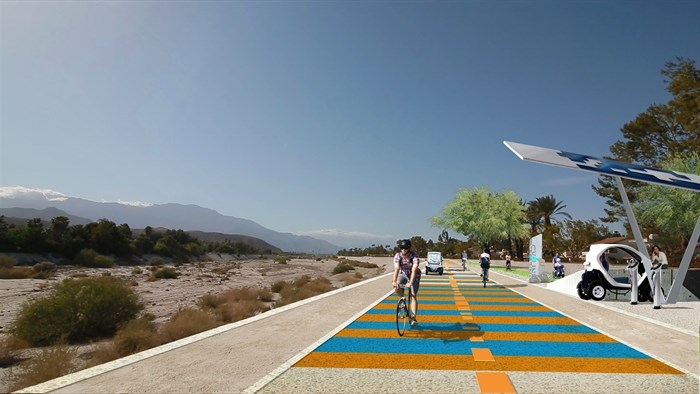
An artist's rendering of the CV Link.
Image Credit: Coachella Valley Association of Governments
May 14, 2016 - 11:30 AM
TRAIL PROJECT IN CALIFORNIA'S COACHELLA VALLEY HOLDS VISION OF FUTURE POSSIBILITIES
OKANAGAN VALLEY - It’s not looking its best right now, a little worse for wear and tear, 48-kilometres long and half ripped up with piles of old railway ties lying along its length.
But like it or not, the Okanagan Rail Trail is ours and the question now is what to do with it. Not in the short term — that’s been decided with plans for a basic trail already in place — but longer term where the possibilities are many.
Doug Gilchrist has spent a lot of time thinking about trails as the leader of the team that negotiated the purchase of the rail corridor from CN Rail.
His diplomatic advice: “Go slow and see how people use it at first, get the community interested and listen to what they have to say.”
But if he had his way, the Okanagan Rail Trail might eventually look like the CV Link, a 80-kilometre trail project in California’s Coachella Valley that Gilchrist holds up as a shining example of future possibilities.
“That’s really out there, the next level of thinking,” Gilchrist says.
Construction begins next year and when complete, the $100-million CV Link will connect eight towns in the valley from Palm Springs to the town of Coachella using the top of the levee on the Whitewater River.
What sets this project apart from other trail projects — there are hundreds around the world using abandoned infrastructure — is the plan to add low speed electric vehicles into the usual trail mix of pedestrians and cyclists.
Tom Kirk, executive director of the Coachella Valley Association of Governments, says the idea of using the levee for something other than flood control had been around for years but the concept of linking communities with a multi-use pathway and allowing low-speed electric vehicles access to it is just a few years old.
“They have been talking about bike paths and freeways for years but none of them were serious,” Kirk says. “We have 120 golf courses in the valley so there’s lots of electric vehicles running around.”
The idea was born from conversations, not with the local tourist association, but with the Riverside County supervisor and the head of the Desert Healthcare District.
“They were concerned about the prevalence of childhood obesity in the Coachella Valley,” Kirk says.
This is reflected in the link’s funding model. While tourism is definitely part of the equation, CV Link is at this point, primarily funded by grants from various levels of government aimed at boosting public health, reducing traffic congestion and improving air quality.
Grants worth $76 million are already in place, with no taxation money required (at least for now) from local governments.
Credit: Coachella Valley Association of Governments
ELECTRIC VEHICLES A GAME-CHANGER
As for the link’s $100-million price tag, Kirk views it as relatively low, given the association is in the process of replacing one highway interchange for $80 million.
“Here you have one tiny piece of infrastructure we have put in place for really what is just one part of the transportation picture, the automobile, compared to building something for everybody: seniors, kids, the disabled and everyone in between… for $100 million seems like a bargain to us,” Kirk says.
And that’s before factoring in the estimated economic, health and social benefits to the 400,000 people living in the Coachella Valley.
The CV Link master plan predicts a minimum return of almost $9 for every dollar invested in building and then maintaining the trail until 2035.
That includes over $500 million injected into the local economy from increased tourism and a $95-million boost to property values but also means $87 million in lower health care costs connected to obesity and another $80 million from the reduced impact of pedestrian and cyclist deaths and injuries.
Beyond all that, the CV Link aims for a higher social purpose, providing a low-cost transportation alternative for low-income valley residents, saving them money and improving health outcomes.
When operational, the link is projected each year to eliminate 43.5 million vehicle trips and 144.5 million vehicle miles reducing CO2 emissions by 117.5 million pounds, especially important in a desert area plagued by fine particle dust.
Obstacles are many. The $100 million will be used to take the link over a major highway and the flood channel itself, plus pay for numerous undercrossings, access ramps and street-level crossings.
The eventual goal is not one but two parallel trails, one a grade-separated lane dedicated to bikes and electric vehicles and another, softer track for those on foot.
Success of the link, to some extent, will depend on the uptake of so-called low-speed and neighbourhood electric vehicles, but the master plan predicts strong interest and a burgeoning second-hand market as the link grows in popularity.
Of course, not everyone loves the CV Link — residents of several large golf resorts demanded it be routed around them — and Kirk says it, like other civic projects, garners about equal parts apathy and interest from local residents.
“Certainly there is opposition and also a lot of support. This project is no different, you get your ardent supporters and folks very opposed to the project,” he says.

Image Credit: Coachella Valley Association of Governments
SOME SIMILARITIES, BIG DIFFERENCES
Back in the Okanagan Valley, the parallels between the CV Link and our own rail trail are temptingly obvious.
Both projects are driven by a cluster of communities in a golf-oriented valley seeking to connect through a transportation link that isn’t a highway. And both seek to benefit from the economic and health benefits a legacy project like this holds out.
The differences are obvious, too. The Coachella Valley holds twice the population of the area to be served by the Okanagan Rail Trail, giving it economy of scale. Those are also U.S. dollars they’re using.
And unlike the CV Link, which has $76 million in grant money already in place, the development of the Okanagan Rail Trail will depend on an ongoing private donation campaign.
Despite that, Gilchrist also believes the Okanagan deal was a steal.
“I think the rail trail is fantastic on many fronts. It would easily have been worth it at twice the price,” he says. “I think the eventual value to the community is worth much more than what we paid for it."
In his role as director of community planning and real estate Gilchrist oversees the acquisition of property for the City of Kelowna so he’s not one to get too excited about a project.
This one’s different.
“I think it will be wildly successful and I think there will be huge public pressure to advance the project, whatever that comes to mean,” he says. “I think it will eventually define us as much as City Park or Knox Mountain. In fact, it will be serving a greater purpose, as an alternative transportation corridor."
PART TWO: The bigger picture: How about a 250-kilometre trail from Sicamous to Osoyoos?

Image Credit: Coachella Valley Association of Governments
News from © iNFOnews, 2016